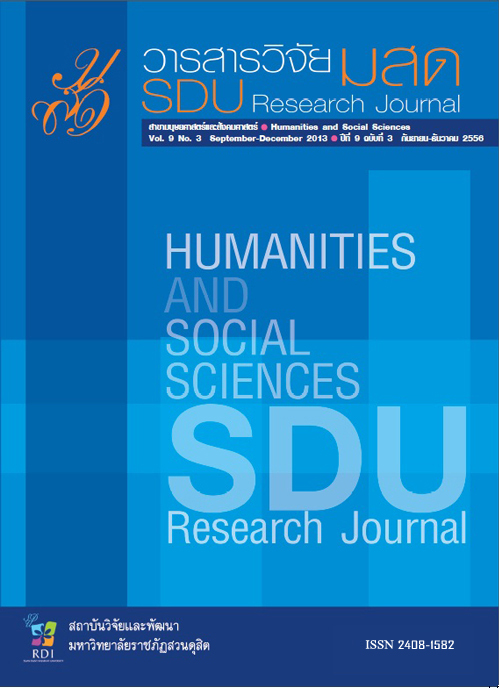พฤติกรรมนักท่องเที่ยว; แหล่งท่องเที่ยว; ทะเลบัวแดง; นักท่องเที่ยว
Keywords:
พฤติกรรมนักท่องเที่ยว, แหล่งท่องเที่ยว, ทะเลบัวแดง, นักท่องเที่ยวAbstract
บทคัดย่อ
การวิจัยครั้งนี้ มีวัตถุประสงค์เพื่อศึกษาพฤติกรรมการท่องเที่ยวและศึกษาความสัมพันธ์ระหว่างลักษณะทางประชากรศาสตร์กับพฤติกรรมนักท่องเที่ยวชาวไทยที่มีต่อการท่องเที่ยวแหล่งท่องเที่ยวทะเลบัวแดง กลุ่มตัวอย่างเป็นนักท่องเที่ยวชาวไทยที่เดินทางมาท่องเที่ยวแหล่งท่องเที่ยวทะเลบัวแดง จำนวน 1,000 คน โดยวิธีการสุ่มตัวอย่างแบบบังเอิญ ทำการเก็บข้อมูลด้วยแบบสอบถาม สถิติที่ใช้ในการวิเคราะห์ข้อมูล ได้แก่ ค่าร้อยละ ความถี่ และสถิติการทดสอบไคสแควร์ ผลจากการวิจัย พบว่า ด้านพฤติกรรมการท่องเที่ยว โดยส่วนใหญ่มีวัตถุประสงค์ของการท่องเที่ยวเพื่อเป็นการพักผ่อนและเปลี่ยนบรรยากาศ มีการจัดการท่องเที่ยวด้วยตนเอง นักท่องเที่ยวส่วนใหญ่จะไม่เลือกพักค้างแรม ส่วนกลุ่มนักท่องเที่ยวที่พักค้างแรมจะเลือกสถานที่พักแรม คือ บ้านญาติหรือเพื่อน เนื่องจากประหยัดค่าใช้จ่าย และเลือกสถานที่พักแรมที่อยู่ในตัวเมืองจังหวัดอุดรธานี ยานพาหนะที่ใช้ในการเดินทางเป็นรถยนต์ส่วนบุคคล มีผู้ร่วมท่องเที่ยวคือเพื่อน จำนวน 2 – 3 คน ใช้ระยะเวลาในการท่องเที่ยว 1 วัน มีการวางแผนล่วงหน้าและการจัดสรรเงินสำหรับการท่องเที่ยว มีค่าใช้จ่ายเฉลี่ยสำหรับการท่องเที่ยวไม่เกิน1,000 บาทต่อคน โดยค่าพาหนะเดินทางเป็นค่าใช้จ่ายที่มากที่สุด โดยส่วนใหญ่ตัดสินใจเดินทางท่องเที่ยวด้วยตนเอง มีการรับรู้ข้อมูลเกี่ยวกับแหล่งท่องเที่ยวทะเลบัวแดงจากอินเทอร์เน็ต และกำหนดช่วงเวลาในการเดินทางท่องเที่ยวคือ วันหยุดสุดสัปดาห์ จากการทดสอบไคสแควร์ พบว่า อายุมีความสัมพันธ์กับวัตถุประสงค์ของการท่องเที่ยว รูปแบบการท่องเที่ยว ผู้ร่วมเดินทางท่องเที่ยว รายได้เฉลี่ยมีความความสัมพันธ์กับการพักแรม สถานที่พักแรม ยานพาหนะในการเดินทาง ระยะเวลาในการท่องเที่ยว ค่าใช้จ่ายสำหรับการท่องเที่ยวและระดับการศึกษามีความสัมพันธ์กับการวางแผนการท่องเที่ยว อย่างมีนัยสำคัญทางสถิติที่ระดับ .01
คำสำคัญ: พฤติกรรมนักท่องเที่ยว แหล่งท่องเที่ยว ทะเลบัวแดง นักท่องเที่ยว
Abstract
The purposes of this research were to study tourism behaviors and to investigate the relationships between Thai tourists' demographic characteristics and behaviors and their visits to the Red Water Lily Lake.
Sample of this study was 1,000 Thai tourists who spent their visits at the Red Water Lily Lake recruited usingaccidental random sampling method. The data collection instrument was a questionnaire. Statistics used for data analysis included percentage, frequency, and Chi-square.
The findings reveal that regarding tourists' behaviors, the majority of tourists visited the Red Water Lily Lake for their leisures and to have a break from their regular daily environments, planned thier own travels, and did not stay overnight. For tourists who stayed overnight, they would stay with their relatives or friends because they didn't have to pay for accommodation and chose to stay in the city of Udon Thani. The mostly chosen transportation was private cars. The majority of tourists traveled in small groups of two to three people and the duration of visit was one day. The visits were planned previously and the expenses for each visit were within 1,000 Baht per person and the largest amount was spent on transportation. For deciding the visit, most tourists made decision to visit the lake themselves. The channel the tourists received the information about the Red Water Lily lake the most was the internet and the days for the visits were weekends. The results of Chi-square test indicate the relationships were found: between ages and purposes of travel, tourism patterns, and travel companions; between average income and overnight stay, accommodation, transportation, duration of visit, and expense; and between education and travel planning significantly at .01.
Keywords: tourism behavior, tourist destination, red Water Lily Lake, tourist








